Late in September, and with one week's notice of the event from the Publicity People, I approached my Level 2 students and invited them to enter the Young Baker of the Year Competition.
This was hosted by Warburton's, who are one of the "Big 3" baking companies who dominate bread sales in the UK. Six students entered and prepared their own recipes, which they spent a couple of weeks perfecting. Of these, two were chosen to compete in the Regional Final held at Warburton's Bakery on the outskirts of Newcastle upon Tyne on Friday 15th September.
There were 5 students in the Final: 2 from Middlesbrough College, 1 from South Tyneside, plus Katie and Faye from Newcastle College.
The recipes are posted below. There are also some photos from the event. The loaves were made the day before and taken along for selected staff and managers at the Warburton's Bakery to judge.
Katie made bread using a local stout to make a traditional barm. She also included a linseed soaker. Fantastic recipe; malty with hydration at 75%: very attractive and flavoursome! Faye used nettles, gathered from her own garden. The bread was made with a white levain, and lightly spiced with roasted cumin and coriander. Thanks Karin [hanseata] for your post which was the original source of some inspiration!
Hey, Faye was the winner! She won £250, and now has a place in the National Final. The prize for that is £1000, plus a work placement at a Warburton's Bakery! The Final is a live "bake-off" at the HQ in Bolton, near Manchester, on 10th November. How exciting; I can hardly wait to get on that train myself!
Baker Competition
Stout and Flaxseed Bread.
|
|
Stout and Linseed Bread Recipe |
|||
|
|
|
|
||
|
Barm |
Formula (g) |
Recipe (g) |
||
|
Strong White Flour |
25 |
750 |
||
|
Beer |
25 |
750 |
||
|
Yeast |
0.2 |
6 |
||
|
Total |
50.2 |
1506 |
||
|
|
|
|
||
|
Soaker |
Formula (g) |
Recipe (g) |
||
|
Golden Linseed |
10 |
300 |
||
|
Water |
30 |
900 |
||
|
Total |
40 |
1200 |
||
|
|
|
|
||
|
|
|
|
||
|
Final Dough |
Formula (g) |
Recipe (g) |
||
|
Barm |
50 |
1506 |
||
|
Soaker |
40 |
1200 |
||
|
White Flour |
50 |
1500 |
||
|
Brown Flour |
25 |
750 |
||
|
Beer |
20 |
600 |
||
|
Salt |
1.8 |
54 |
||
|
Fresh Yeast |
2 |
60 |
||
|
Total |
189.0 |
5670 |
||
|
|
|
|
||
|
|
|
|
||
Bread Method
Firstly the... Over Night soaker-
Weigh out 300g of golden linseed into a bowl and add the 500g of cold tap water.
Leave over night in a cool place for approx. 7 hours.
Then the...Over Night Barm-Beer ferment-
Weigh into a large bowl 750g of strong white bread flour- preferably Canadian and rub in the 6 g of fresh yeast gently with your fingers. Then pour in 750 of dark Allendale stout. Just combine the mixture to a paste then cover bowl to make airtight. Leave this in a reasonably cool place over night. 6-7 hours.
On the Day the...Final Dough-
Weigh out dry ingredient first, the white and brown flour into a large mixing bowl. Rub in the fresh yeast gently with fingers and pour the salt to one side of the bowl. Weigh out the overnight soaker and add this to the bowl then weigh out the barm and add this also. Weigh out and add the stout. Attach to a mixing machine then attach the dough hook. Place on number 1 or lowest speed for 10 to 15 minutes. Periodically scrape excess dough from the sides and bottom of the bowl. After 10 minutes of mixing take a piece of dough and check the elasticity-the window pane method. If the dough doesn't stretch out enough place back onto a slow mix.
When mixed, take the dough out of the mixing bowl. Lightly grease another large bowl with shortening/butter. Very gently knead the dough in the bowl, cover with a cloth and leave in a warm place for ten minutes. Take bread dough out of bowl and weigh into 1kg pieces, then shape each piece into ovals/ balls. Sprinkle a dusting of semolina and brown flour into large bread proving baskets and transfer each loaf smooth side up into each basket. Then place baskets into a prover for about an hour until the bread has doubled and is not over proved.
Transfer each loaf onto a peel finely dusted with semolina and slash each top with a lame as desired.
Pre-heat the baker's oven to 210°C. Place in the oven for up to 25 minutes and pump the oven with steam straight after the bread is on the oven sole. Open the dampers, and bake a further 5 minutes. Cool on wires. [Photos Below]
Nettle Bread [Photos Above]
Makes a large loaf of 1000grams and a smaller loaf of 450grams.
Pre ferment - Wheat Levain
Flour 284g
Water 170g
Total 454g
Final Dough
Flour - 568g
Salt - 16g
Yeast - 24g
Preferment - 454g
Water - 367g @ 20 degrees centigrade
Roasted cumin seeds - 3g
Coriander seeds - 4g
Dried nettle - 4g
Oven dry the nettles
Roast off the cumin
Crush the coriander seeds in a pestle and mortar
Boil 200g of water with a bunch of nettles and allow to cool
Place the flour, salt, preferment and yeast in a mixing bowl and the 200g of nettled water and 167g of cool water combined with a temperature of 20 degrees.
Place the mixing bowl on the machine and mix on speed 1 for 3 minutes
Then mix on speed 3 for 6 minutes until fully mixed
Mould the dough and rest for 5 minutes
Divide the dough into one small 450g loaf and a 950g loaf and shape
Place into baskets and place in the prover
Prove for 45 minutes to an hour at 35 degrees
Bake @ 220 degrees in a deck oven with the top to be set at 6 and bottom at 5 for 25 minutes.
Remove from oven place on wires and allow to cool.
To be fully enjoyed serve with cheese or soup.
I made the following breads at home over the half term holiday:
Pain Siègle
|
Material |
Formula [% of flour] |
Recipe [grams] |
|
1. Rye Sour |
|
|
|
Dark Rye Flour |
10 |
169 |
|
Water |
16.6 |
281 |
|
TOTAL |
26.6 |
450 |
|
|
|
|
|
2. Final Dough |
|
|
|
Rye Sour [from above] |
26.6 |
450 |
|
Strong White Flour |
90 |
1521 |
|
Water |
51.4 |
868 |
|
Salt |
1.8 |
30 |
|
TOTAL |
169.8 |
2869 |
Pre-fermented Flour: 10%. Overall Hydration: 68%
Method:
- Build/elaborate the leaven and ferment overnight for 18 hours prior to use
- Combine all the final dough ingredients, except the salt, and "autolyse" for one hour.
- Add the salt and mix the dough for 15 minutes to fully develop.
- Bulk ferment for 3 hours with 2 S&F...hourly intervals
- Scale and divide into 2 equal sized pieces.
- Mould round and place upside down in prepared bannetons.
- Final proof is 1½ to 2 hours. Cut the top of the loaf just prior to baking.
- Pre-heat the oven to 250°C. Bake with steam for 20 minutes. Drop the heat to 210 °C and bake a further 35 minutes.
- Cool on wires
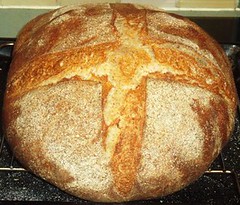

White Levain with a Seed Soaker
This was a cold soaker, using sesame and blue poppy seeds with no salt addition. These were soaked for six hours prior to dough mixing. I utilised an overnight retard for this bread.
|
Material |
Formula [% of flour] |
Recipe [grams] |
|
1. Levain |
|
|
|
Strong White Flour |
33.3 |
480 |
|
Water |
20 |
288 |
|
TOTAL |
53.3 |
768 |
|
|
|
|
|
2. Soaker |
|
|
|
Sesame Seeds |
5.2 |
75 |
|
Blue Poppy Seeds |
5.2 |
75 |
|
Water |
31.2 |
450 |
|
TOTAL |
41.6 |
600 |
|
|
|
|
|
3. Final Dough |
|
|
|
Levain [from above] |
53.3 |
768 |
|
Soaker [from above] |
41.6 |
600 |
|
Strong White Flour |
66.7 |
960 |
|
Water |
20.8 |
300 |
|
Salt |
1.9 |
28 |
|
TOTAL |
184.3 |
2656 |
|
Overall Hydration |
72% |
|
|
Pre-fermented Flour |
33.3% |
|
Method:
- Elaborate the levain and make the soaker 6 hours in advance
- Mix all the ingredients to form the final dough, and fully develop this for 15 minutes.
- Bulk prove ambient for 2 hours.
- Retard overnight at 3°C in the fridge, covered.
- Scale and divide in 2. Mould round, top with a mix of the seeds and prove in bannetons.
- Bake profile is as Pain Siègle. Cool on wires.
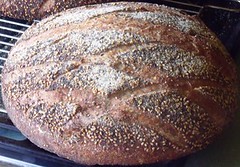
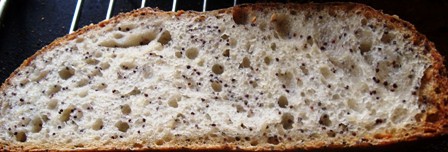
Best wishes to you all
Andy
- ananda's Blog
- Log in or register to post comments
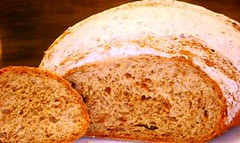

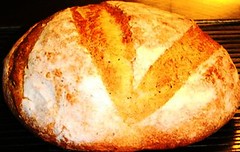
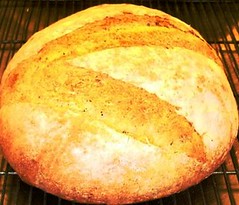
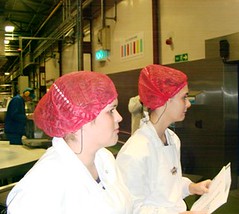


Congratulations, Andy!
Students need a good teacher like you to achieve success!
and the whole team! Well done!
Sylvia
Thanks both LindyD and SylviaH,
Both these students have been in the College for some time now, having completed the Level 1 Baking with me first then moving to Level 2.
I think this extra experience has helped them to suucceed in this project and will no doubt carry them further.
Lovely to hear from both of you
Andy
What a great news! They all look fabulous, of course!!
And I have a few question for you. I am a begginer for sourdough bread making so that should be silly questions.
Why do you take one hour for aultolize on the Pain Siègle ?
Another question is about White Levain with a seed soaker:
The levain is used only the strong flour and water , isn't ? It will be cultured within 6 hours?
I am interested in these recipes.
Sincerely,
Akiko
Hi Akiko,
Many thanks for posting your compliments to my students; it is really good to hear from you.
Regarding "autolyse": I use this as a trick to fully hydrate the dough. Allowing the flour and water to "stand" for a period of time when just mixed together enables the carbohydrates and proteins to fully hydrate. Given the use of dark rye flour @ 10% in the formula [and it is a very coarse and dark grind indeed!], there is an inevitable tendency to stickiness at a hydration which I regard as relatively high [I appreciate others may disagree on this]. Usually the leaven portion would not be included in the "autolyse". However, I maintain my rye sour at 100 flour: 167 water, so it is a liquid starter. It is common practice to include liquid starters in the autolyse in order to ensure the hydration is sufficient. If it were left out, the mix would be too dry and the purpose of the autolyse would be redundant. Commercially, autolyse was introduced by Prof. Calvel in France in the 1950s as a counter measure to all the over-mixing he witnessed in the post war "industrial bread revolution" in France. He bemoaned over-oxidised dough with its bleached out pigmentation for lack of flavour. Autolyse was his answer to reduce the need for such intensive mixing. But my preferred reason for autolyse is that discussed above. Hamelman is very good on this, if you have his book.
As regards the elaboration: I have stopped including my feeding regime in these recipe posts. In all honesty, I just don't have the time to record this level of detail these days. So the figures given show the amount of total flour and water in the leaven portion used once it is refreshed and ready to add to the final dough. I keep 2 leavens in stock all the time, in the fridge, and feed as needed to maintain them. They are given at least a couple of feeds to refresh them properly in the elasboration steps leading up to baking with them. The wheat leaven is maintained at 100 flour: 60 water, the rye as shown above. The 6 hour figure mentioned is the time elapsing between the final feed of the leaven and actually using it to make the dough. Generally, 4 hours would be a minimum [average of the conditions in my house] time; any more than 6 and I would slow down activity with some refrigeration. The rye, however, is used as a real "sourdough", as opposed to levain. It is fully fermented through for 18 hours so there is a distinct acid presence to aid the stability of the pentosans. Notice in the Pain Siegle formula, the rye sour makes up only 10% of the total flour in the formula, whereas the wheat levain is 33% of the total flour. This is quite a deliberate formulation on my part.
I hope this gives a little further insight into the wonders of sourdough baking?
Best wishes
Andy
Thank you for taking a time to write back to me.
Yes, It does!! Thank you!
I have Hamelman's book. This is the most useful book I ever had. I haven't finished reading yet. But so far it is very working for me.
I havn't used dark rye flour yet. Thank you for the information, Andy. It is good to know about it before using!
I better check your track to read more about sourdough and learn more :)
I appreciate all your work. Thank you very much, Andy.
Akiko
It's your success as much as theirs!
I am especially interested in the seeded levain, might have to try that soon!
That's a really nice reminder txfarmer.
Of course, it's also a success for the College. It is only 3 years since I re-introduced specialist baking programmes into the curriculum there. Prior to that, the original Bakery School had been shut some 7 years before, and the only activity was some pastry skills for the culinary students.
The seeded levain was born from a need to feed my white leaven, and the fact I had some Blue Poppy and Sesame Seeds in the store cupboard. It does have a really good balance of crunchiness to the nice soft crumb.
My freezer is now FULL!
BW
Andy
Good luck to your student for the Final competition!
David
Great to hear from you again. Well done!
Thanks David and hansjoakim
It's really good to hear from both of you too
BW
Andy
Well done Andy to you and the girls, good to see you back, i know that you have been busy with your own studies. great breads there. How is the WFO going
Regards Yozza
Hi Yozza,
Yes, I'm up early with head buried in a book on Food Policy, and it's just after 7am here!
Thanks for posting your compliments, it's really good to hear from you.
The WFO is in need of an "outing". I probably need to break up some of the wood I have in the store first. My electric oven is struggling to cope with the home baking and keeps cutting out at the most inopportune moments! Still, the freezer is now bursting, so I won't be baking at home til into December I reckon.
So much to do between now and then!
And, how the devil are you? I trust you are on the mend now?
All good wishes
Andy
Hi Andy
The mend is going really well, I thought i reached a milestone and became ambidextrous with toilet paper, nobody other than the physio seemed to think that was either noteworthy or something they needed to know. Driving will be the next big thing after 2 months now an a return to work still a month away. Although im thinking of taking the time off to christmas as dad is supposed to be coming from the UK in a few weeks if he is passed fit to fly at 83.
I shall have to organise my passport as it has been expired for 3 years and i am due long service leave and time to return to the mother land and hopefully catch up with you and some of your great students whilst im there.either 2011 or 2012.
kind regards yozza
Hi
For Daisy_A and Akiko: yes, indeed, rye flour is notoriously inconsistent in terms of hydration requirements. A little warning, however: if you have flour which you seem to have to just keep on adding water ad infinitum, then you have some poor flour, and will be heading for trouble when it comes to baking. This is why I tend to stick at around 85% hydration for the all-rye sourdoughs. Any higher, and it is very difficult to bake out the bread! I'm aware that Andrew's formula for his basic rye sourdough bread has very high water content. Please keep this in mind. This is especially true for the Dark Rye; the more refined Light Rye tends to be more consistent, and will not need quite so much water.
Yozza, yes, get that passport renewed! Look forward to your visit to the cold northern climes!
Best wishes
Andy
Hi Andy,
This is a terrific achievement for both your students and yourself, and of course the College. It's apparent that Faye and Katie have had excellent instruction while at your College, judging by the quality of the breads they've made. You and all the other instructors involved in their education deserve a hearty well done!
It's apparent as well that both of the girls have a natural talent for baking, and for formulating or adapting a recipe based on an 'idea' and available local ingredients. It shows a lot of imagination and creativity on their part which will serve them well in their future careers.
As for your breads... they look wonderful as always. It good to see you back on TFL my friend .
Cheers,
Franko
Hi Franko,
Thank you for your very kind words.
I agree, Katie and Faye do have plenty of natural talent, which will be key to their future successes. I suspect they would both like to set up their own businesses in years to come...ambitions held even before they enrolled at College.
There is only one baking instructor in our school; so they are stuck with me! But, I like being the only baking specialist, and I guess both these young women remain suficiently motivated too. It is always re-assuring when students actively seek further progression.
My posts may be more intermitent at times, but I'm not going away. Really good to hear from you
BW
Andy
I absolutely agree, Andy, it's your success as well as your students'. Given the downsizing of the baking program and your holding down the fortress all by yourself, you really inspired and supported them to achieve such wonderful success.
I'm happy to hear that Faye could use the idea of seasoning with nettles. This is one of the great advantages of TFL - sharing information and experiences and inspiring each other!
I have copied all four recipes. Fortunately my MacGourmet recipe program has unlimited storage space - much different from my freezer that suffers from the same "constipation" as your.
Karin